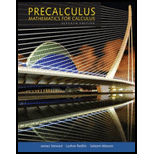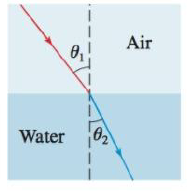
Refraction of Light It has been observed since ancient times that light refracts, or “bends,” as it travels from one medium to another (from air to water, for example). If v1, is the speed of light in one medium and v2 is its speed in another medium, then according to Snell’s Law,
where θ1 is the angle of incidence and θ2 is the angle of refraction (see the figure). The number v1/v2 is called the index of refraction. The index of refraction for several substances is given in the table.
If a ray of light passes through the surface of a lake at an angle of incidence of 70°, what is the angle of refraction?

| Substance | Refraction from air to substance |
| Water | 1.33 |
| Alcohol | 1.36 |
| Glass | 1.52 |
| Diamond | 2.41 |
Trending nowThis is a popular solution!

Chapter 7 Solutions
Precalculus: Mathematics for Calculus (Standalone Book)
Additional Math Textbook Solutions
Mathematics for the Trades: A Guided Approach (11th Edition) (What's New in Trade Math)
Elementary & Intermediate Algebra
College Algebra (Collegiate Math)
Calculus: Early Transcendentals (2nd Edition)
Elementary Statistics ( 3rd International Edition ) Isbn:9781260092561
Precalculus: A Unit Circle Approach (3rd Edition)
- 1 1. Suppose we have the function f(x) = = and then we transform it by moving it four units to the right and six units down, reflecting it horizontally, and stretching vertically by 5 units. What will the formula of our new function g(x) be? (2 points) g(x) =arrow_forwardSuppose an oil spill covers a circular area and the radius, r, increases according to the graph shown below where t represents the number of minutes since the spill was first observed. Radius (feet) 80 70 60 50 40 30 20 10 0 r 0 10 20 30 40 50 60 70 80 90 Time (minutes) (a) How large is the circular area of the spill 30 minutes after it was first observed? Give your answer in terms of π. square feet (b) If the cost to clean the oil spill is proportional to the square of the diameter of the spill, express the cost, C, as a function of the radius of the spill, r. Use a lower case k as the proportionality constant. C(r) = (c) Which of the following expressions could be used to represent the amount of time it took for the radius of the spill to increase from 20 feet to 60 feet? r(60) - r(20) Or¹(80-30) r(80) - r(30) r-1(80) - r−1(30) r-1(60) - r¹(20)arrow_forward6. Graph the function f(x)=log3x. Label three points on the graph (one should be the intercept) with corresponding ordered pairs and label the asymptote with its equation. Write the domain and range of the function in interval notation. Make your graph big enough to see all important features.arrow_forward
- Find the average value gave of the function g on the given interval. gave = g(x) = 8√√x, [8,64] Need Help? Read It Watch Itarrow_forward3. Mary needs to choose between two investments: One pays 5% compounded annually, and the other pays 4.9% compounded monthly. If she plans to invest $22,000 for 3 years, which investment should she choose? How much extra interest will she earn by making the better choice? For all word problems, your solution must be presented in a sentence in the context of the problem.arrow_forward4 πT14 Sin (X) 3 Sin(2x) e dx 1716 S (sinx + cosx) dxarrow_forward
- Let g(x) = f(t) dt, where f is the function whose graph is shown. 3 y f(t) MA t (a) At what values of x do the local maximum and minimum values of g occur? Xmin = Xmin = Xmax = Xmax = (smaller x-value) (larger x-value) (smaller x-value) (larger x-value) (b) Where does g attain its absolute maximum value? x = (c) On what interval is g concave downward? (Enter your answer using interval notation.)arrow_forward2. Graph the function f(x)=e* −1. Label three points on the graph (one should be the intercept) with corresponding ordered pairs (round to one decimal place) and label the asymptote with its equation. Write the domain and range of the function in interval notation. Make your graph big enough to see all important features. You may show the final graph only.arrow_forwardansewer both questions in a very detailed manner . thanks!arrow_forward
- Question Considering the definition of f(x) below, find lim f(x). Select the correct answer below: -56 -44 ○ -35 ○ The limit does not exist. x+6 -2x² + 3x 2 if x-4 f(x) = -x2 -x-2 if -4x6 -x²+1 if x > 6arrow_forwardLet g(x) = f(t) dt, where f is the function whose graph is shown. y 5 f 20 30 t (a) Evaluate g(x) for x = 0, 5, 10, 15, 20, 25, and 30. g(0) = g(5) = g(10) = g(15) =| g(20) = g(25) = g(30) = (b) Estimate g(35). (Use the midpoint to get the most precise estimate.) g(35) = (c) Where does g have a maximum and a minimum value? minimum x= maximum x=arrow_forwardQuestion Determine lim f(x) given the definition of f(x) below. (If the limit does not exist, enter DNE.) x+6+ -2x²+3x-2 f(x) -2x-1 if x-5 if -−5≤ x ≤ 6 3 if x 6arrow_forward
- Algebra & Trigonometry with Analytic GeometryAlgebraISBN:9781133382119Author:SwokowskiPublisher:Cengage
 Trigonometry (MindTap Course List)TrigonometryISBN:9781337278461Author:Ron LarsonPublisher:Cengage Learning
Trigonometry (MindTap Course List)TrigonometryISBN:9781337278461Author:Ron LarsonPublisher:Cengage Learning Trigonometry (MindTap Course List)TrigonometryISBN:9781305652224Author:Charles P. McKeague, Mark D. TurnerPublisher:Cengage Learning
Trigonometry (MindTap Course List)TrigonometryISBN:9781305652224Author:Charles P. McKeague, Mark D. TurnerPublisher:Cengage Learning


